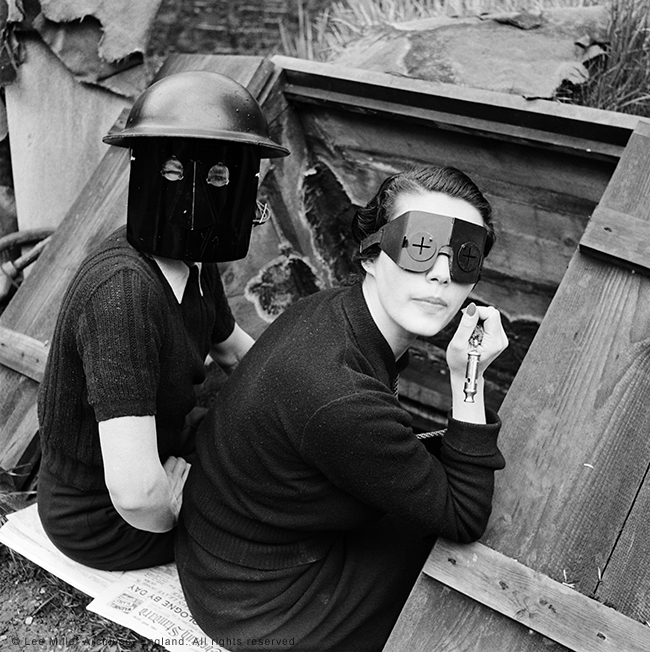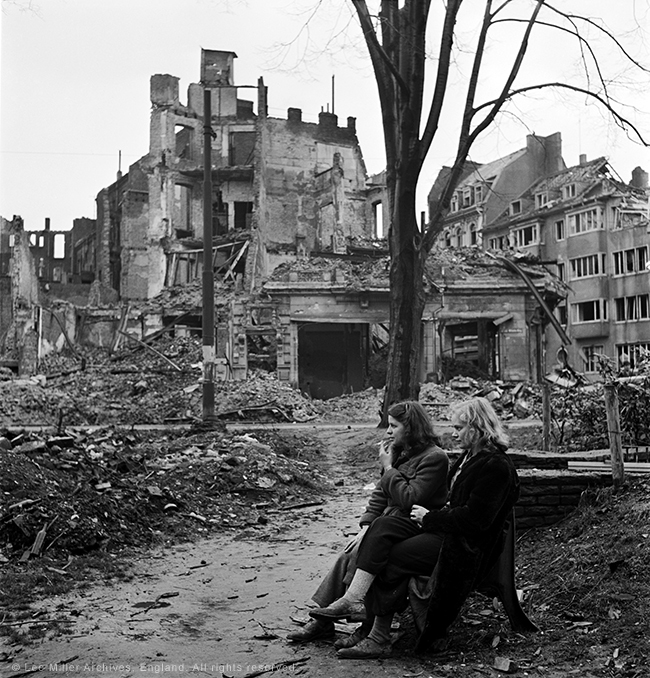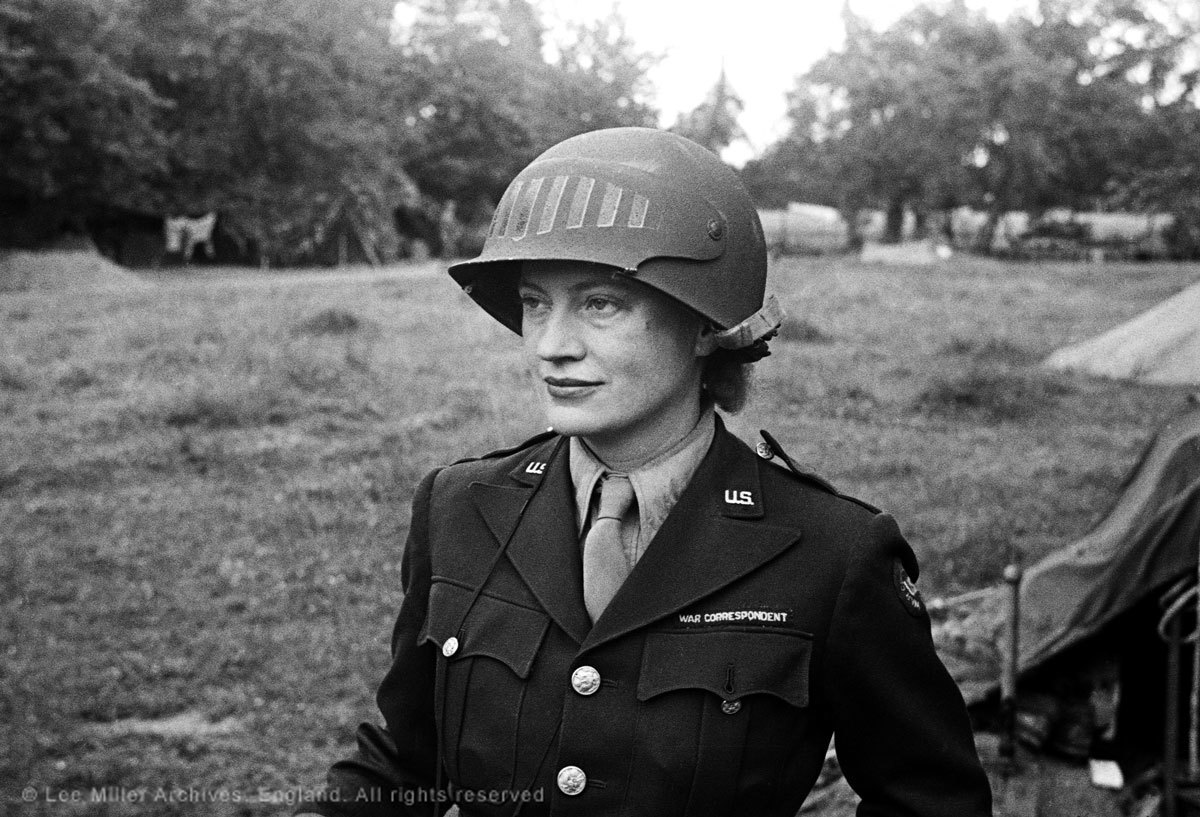There are many faces to Lee Miller. She is the young, vulnerable nude in her father’s amateur photographs, a distorted, colourful figure in Picasso’s paintings, a supermodel whose image was captured by Edward Steichen, Arnold Genthe, Nickolas Muray or George Hoyningen-Huene. Man Ray’s Lee is a classic surrealist muse, glowing with solarisation. Roland Penrose paints her silhouette, obscured by symbols. Finally there’s the Lee of David E. Scherman, a war-time siren, fearless in her Savile Row uniform.
Since her death, her son, Antony Penrose, has been working hard to show us the woman that existed beyond the gaze of these men. As he puts it, each of them “took a little piece of her for themselves. She gave it freely, and in return the artist’s images of her retain a vital spark and immortalise her.” Immortal though she may be, she immortalised each of them in return, and in doing so allowed the world to forget that Lee Miller was much more than a model, a lover and a muse. As she said herself, “I’d rather take a picture than be one”.
Luckily, it seems she more than fulfilled this preference. Just weeks after she passed away, whilst clearing out the attic, her son found 60,000 of her original negatives, alongside 20,000 prints and contact sheets. Here we see the woman looking out at the world, rather than it looking in at her.

The images are visible in an online archive but a selection is also on display at the IWM exhibition Lee Miller: A Woman’s War. Many of these photographs were taken during Lee’s time as official war photographer for British Vogue. As one of only four female photojournalists accredited to the US armed forces, Lee documented the liberation of France, Belgium and Luxembourg before accompanying the American advance into Germany. At the liberation of Dachau in 1945 she cabled Vogue: “I IMPLORE YOU TO BELIEVE THIS IS TRUE”. Vogue didn’t doubt her; the images spared nothing. Mark Haworth-Booth, curator of the V&A show The Art of Lee Miller, told the NY Times in 2007: “She got very close to things. Margaret Bourke-White [one of the other four female photojournalists] was far away from the fighting, but Lee was close. That’s what makes the difference — Lee was prepared to shock.”
Through A Woman’s War, curator Hilary Roberts questions whether gender impacted on Lee’s work. Photographing death on the front-line, and cold-blooded murder in the German concentration camps, Lee had to function “without any concession to her gender in a harsh and dangerous environment from which women were traditionally excluded.” Sure, Lee could outdrink most of the lads, and lived under gunfire in the same terrifying conditions as the GIs; yet her eye allowed her to engage with what she was seeing in a way that ultimately produced some of the most moving war photography of the time.
What was most inspired, though, was Lee’s documentation of the unarmed warriors — the women who were left behind and had to keep their countries going while the boys were away. With tact and composure, Lee depicts these women as strong individuals, not figures who needed protection or pity. You can tell these women feel comfortable around her, and this gave her access to areas no male photographer could have ventured into. We see women in their living quarters, knickers strung out on the washing-line, or a few of the girls lying giggling in a heap. She also shows women in professional positions they otherwise never would have dreamed of; capturing female officers, pilots, electricians and secret agents. Pretty much everything except pulling the trigger of a gun (women were still considered ‘non-combatants’) became available to them at the time.

Once the blitz began and clothes rationing was introduced, fashion began to seem trivial and somewhat inappropriate. Thanks to the vision of Lee and the then editor of Vogue, Audrey Withers, these pictures made it into one of Britain’s most elitist publications. In this period, Vogue published a very diverse range of images. Women from all social classes and groups, in varying degrees of destitution and hardship, or courage and fortitude, featured. Wartime fashion photographs, promoting short hair for factory workers, were published alongside scenes of ruined towns and piles of bodies. Mark Haworth-Booth commented in the NY Times in 2007, on this unlikely juxtaposition: “After Germany’s surrender, Miller wrote one of her most passionate articles for Vogue, ‘Germans Are Like This’. She wanted people to see how amazingly a fashion magazine like Vogue could publish something so brutal.”
Lee’s career during the war was an exciting and rewarding one, albeit traumatic. In his biography on his mother, Antony suggests that the end of the war and a return to fashion journalism, disheartened her more then the gunshots and death scenes. This was something also foreseen by Audrey, as she wrote in British Vogue’s ‘Victory’ edition in June 1945: “And where do they go from here – the Servicewomen and all the others who, without the glamour of uniform, have queued and contrived and queued, and kept factories, homes and offices going? Their value is more than proven: their toughness where endurance was needed, their taciturnity when silence was demanded, their tact, good humour and public conscience; their continuity of purpose, their submission to discipline, their power over machines… how long before a grateful nation (or, anyhow, the men of the nation) forget what women accomplished when the country needed them? It is up to all women to see to it that there is no regression – that they go right on from here.”

Inevitably, however, the country did regress, although most women did not forget this period of agency and freedom, which is shown so vividly in Lee’s images of nurses, workers, cleaners and mothers, proudly surviving across Europe. For the first time in her life, Lee had created something that was totally hers, and belonged to no man. A photograph taken of her defiantly bathing in Hitler’s bathtub, her muddy combat boots dirtying the floor, is a testament to this. Her tongue in cheek report back to London read “Mein host was not home”- classic Lee, owning it as usual.
A Woman’s War is open at the Imperial War Museum from October 15 – April 24 2016.
The accompanying book, Lee Miller: A Woman’s War by Hilary Roberts is published by Thames & Hudson, £29.95
Credits
Text Lily Bonesso
Photography Lee Miller
